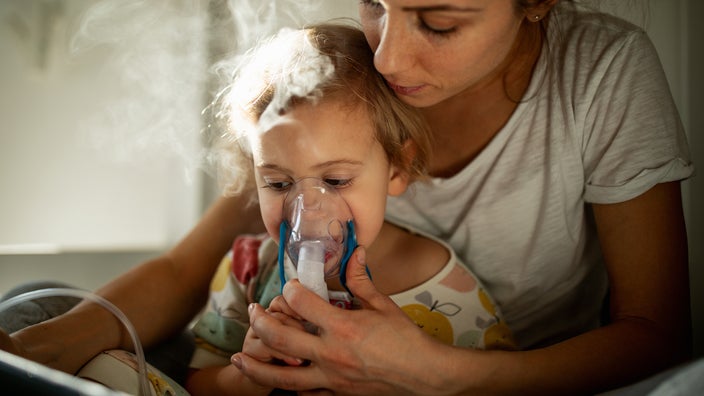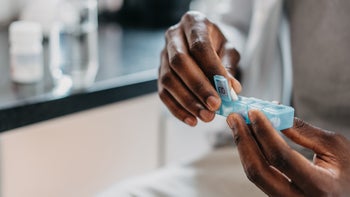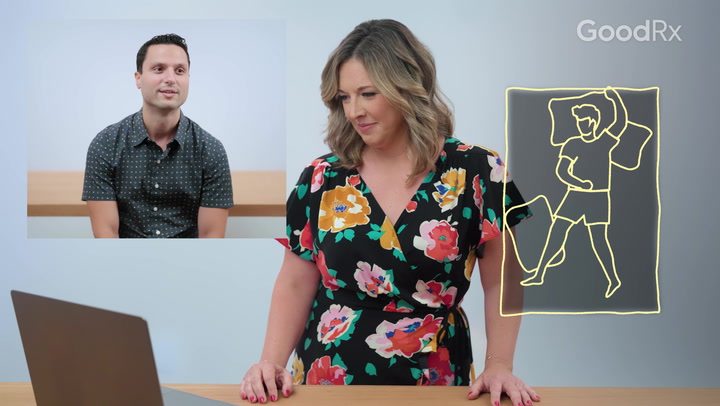
Nebulizers vs. Inhalers: How Do They Compare?
Key takeaways:
Nebulizers and inhalers are medical devices used to treat lung conditions like asthma and chronic obstructive pulmonary disease (COPD).
Nebulizers are large and often more difficult to transport. Inhalers are smaller and more portable. There are also more medications available as inhalers.
Inhalers are more commonly used for lung conditions. But nebulizers may be helpful for young children and people who have trouble using an inhaler.
Table of contents

For people with lung conditions like asthma or chronic obstructive pulmonary disease (COPD), breathing isn't always easy. These lung conditions make it harder for air to pass through the airways and into the lungs.
Inhaled medications — treatments you breathe into the lungs — are important for improving breathing. People with asthma or COPD often use inhaled medications every day to manage their symptoms. Inhalers and nebulizers are two devices used to get medications into the lungs.
But when it comes to nebulizers versus inhalers, is one better than the other?
Quiz: Do I have strep throat?
What’s the difference between nebulizers and inhalers?
Nebulizers and inhalers can both be used to treat lung conditions, such as asthma and COPD. They deliver medication to the lungs to help open up the airways and make it easier to breathe. Delivering medications to the lungs helps them start working faster than if you were to take them by mouth. Inhaling medication also helps lower the risk of many common medication side effects, such as nausea or upset stomach.
Nebulizers and inhalers can be used to prevent or lessen how often you experience symptoms as well. For example, if you have asthma, you might use an inhaled medication every day to help prevent asthma attacks. If you have COPD, you might use an inhaler or nebulizer to help you breathe easier and prevent flare-ups.
Using a nebulizer can seem daunting. This guide breaks down how to use a nebulizer into easy-to-follow steps.
Learning about coverage: Depending on their features, nebulizers can range from tens to hundreds of dollars. Here are the key points to consider when looking at respiratory device costs.
Advocating for your family: One mother shares how she stays on top of her children’s allergy and asthma triggers.
Although nebulizers and inhalers have similar uses, they have several differences to keep in mind.
Nebulizer basics
Nebulizers are machines that change liquid medication into a breathable mist. They don’t come with the medication already included. So you’ll need two prescriptions: one for the nebulizer itself and one for the medication to put into the nebulizer.
To use nebulizers, you have to wear a face mask or breathe through a mouthpiece. The machine also plugs into a wall outlet or uses a battery. Nebulizers tend to be larger and less portable than inhalers. They also take longer to deliver a dose (usually about 10 to 20 minutes per dose).
There are different types of nebulizer machines. But even though various models work differently, the end goal is the same. They turn nebulizer solutions into vapors so they can be inhaled.
How do you use a nebulizer?
Using a nebulizer can seem daunting at first. But with practice, the process becomes easier. Here’s some basic steps to follow for using a nebulizer:
Set up your nebulizer. Every nebulizer is different. So be sure to review your machine’s user manual for set-up instructions. You may need to connect tubing to the mouthpiece or face mask.
Pour the medication into the medicine cup. Your nebulizer turns this liquid into a mist. Be sure to double-check on your prescription label how much medication you should put in the cup for each treatment. Once the medication is added, attach the cup to the mouthpiece or face mask.
Sit in a comfortable position. It's ideal to be in an upright position. Sitting like this helps the medication reach your lungs.
Place the mouthpiece or face mask. Make sure the mouthpiece is between your teeth with your lips sealed around it. Face masks should fit snugly and fully cover your nose and mouth.
Turn on the nebulizer. If your machine has a power cord, plug it into an outlet before turning it on. It’s a good idea to check for a fine mist coming out of the mouthpiece or mask. This means your nebulizer is working properly.
Breathe normally. You don’t need to time your breaths in order for the medication to reach your lungs. If you start coughing while administering your dose, turn off the nebulizer. Once you’re done coughing, turn the machine back on. Continue breathing normally until there’s no more mist coming out of the mouthpiece or mask.
Turn off your nebulizer. Remove the mouthpiece or face mask. If your solution contains a corticosteroid (steroid), rinse out your mouth with water. And if your nebulizer has a mask, be sure to wash your face as well. This helps to prevent a fungal infection of the mouth and throat called thrush.
Clean your nebulizer parts. Be sure to follow your user guide. Cleaning instructions vary between machines.
Inhaler basics
Inhalers are more commonly used than nebulizers. They come in many shapes and sizes. But the principle is the same. You use these devices to inhale medicated spray, powder, or mist into the lungs. Unlike nebulizer, inhalers come with the medication included. So you only need one prescription for the device and the medication.
Inhalers are small and portable, often able to fit in a pocket or purse. But they can be difficult to use properly and may not work as well for some people. For instance, people who have trouble timing their breath to when they push down on the inhaler may not get the full benefits of the medication.
How do you use an inhaler?
There are a few different types of inhalers available. But the most commonly prescribed type is the metered dose inhaler (MDI). This is an L-shaped device that requires you to push down on the top to release a dose.
The steps below explain how to use an MDI:
Read your medication guide. Each MDI has slightly different instructions for use. Always read the guide that comes with your prescription before using it for the first time.
Prime your inhaler if it’s new. Shake your MDI for a few seconds and remove the mouthpiece cover. Point the inhaler away from yourself and others, and spray 1 puff. You may need to repeat this a few times, depending on your inhaler’s instructions. You’ll also need to prime your inhaler if it’s been several days since you last used it. The specific number of days can be found in your medication guide.
Stand or sit upright. This position helps fully expand your lungs.
Shake your inhaler for a few seconds. Remove the mouthpiece cover. Hold the inhaler so that your thumb is supporting the bottom of the mouthpiece and your index and middle fingers are resting on top of the canister.
Take a full breath in and out. After you breathe out, place the inhaler mouthpiece between your teeth. Seal your lips around the mouthpiece.
Breathe in as deep as you can while pushing down on the canister. Release your fingers from the canister and take the inhaler out of your mouth.
Hold your breath and slowly count to 10. If you can’t hold your breath this long, that’s OK. Just hold it as long as you’re able to. Then, breathe out normally. Replace the mouthpiece cover.
If needed, repeat steps 4 through 7. If you inhale 2 puffs per dose, you’ll need to repeat the steps above. Wait about 1 minute between each puff.
Rinse your mouth if your inhaler contains a steroid. This helps prevent oral thrush.
If your inhaler isn’t an MDI, check your medication guide for instructions on how to use it. Your prescriber and pharmacist can also show you how to use your specific inhaler.
What is an albuterol nebulizer?
An albuterol nebulizer is a specific medication that can be used in a nebulizer machine. It isn’t the only nebulizer medication available. But in general, fewer medications are available for nebulizers than for inhalers.
Albuterol is a common example of a medication that can be used in a nebulizer. Other medications include:
Formoterol (Perforomist)
Budesonide (Pulmicort Respules)
What are the side effects of a nebulizer vs. inhaler?
The side effects of a nebulizer versus an inhaler aren’t usually that different. This is because nebulizers and inhalers are devices — not medications. The side effects mainly depend on the medication inhaled with the device.
For example, an albuterol nebulizer is expected to have the same side effects as an albuterol inhaler. Albuterol side effects include:
Rapid heartbeat
Nervousness
Headache
Sore throat
Runny nose
Trouble sleeping
Raised blood pressure
As mentioned above, inhalers or nebulizers that contain steroids can cause oral thrush. Rinsing your mouth with water after inhaling one of these medications to help prevent this side effect.
However, the face mask that comes with many nebulizers can raise the risk of unique side effects. In some cases, the nebulizer mist can stick to your skin, nose, or eyes during a treatment. This could then cause irritation in these areas. Keep in mind that this side effect is also possible if you use an inhaler spacer that contains a face mask.
You also need to clean the various parts of nebulizers regularly to prevent bacteria or fungus buildup. Forgetting to clean them can lead to infections.
When do you use a nebulizer vs. an inhaler?
In some cases, a medication only comes available in one form. So if your medication is only available as an inhaler, then your healthcare team can’t prescribe it as a nebulizer treatment. But when medications come available for both devices, the choice can be more nuanced.
Some experts say that nebulizers should be avoided for long-term treatment of asthma or COPD. But others say that if nebulizers contain long-acting medication, they can be used for daily treatment in some people with COPD.
Inhalers can be used for most people who have asthma or COPD. Inhalers are typically more convenient and affordable than nebulizers. Nebulizers can be a good choice for young children or people who have trouble using inhalers. These people can also use a spacer with some types of inhalers to help them get an effective medication dose.
The choice between nebulizers and inhalers may not be a simple decision for everyone. Your healthcare team can recommend a device that will help you get the best results from an inhaled treatment.
Can you use a nebulizer and rescue inhalers?
Sometimes nebulized medications contain the same ingredients as a rescue inhaler. In this case, you wouldn’t use them together. For example, if you have an albuterol nebulizer and an albuterol rescue inhaler (Ventolin HFA), you typically wouldn’t use them at the same time. This can raise your risk of side effects.
If your nebulizer contains a different medication than your rescue inhaler, you might be instructed to use them both. Your prescriber will give you instructions about using a nebulizer and inhaler together if that’s what they recommend.
Is a nebulizer better than an inhaler for asthma?
Choosing nebulizers or inhalers for asthma has been a debate among experts. Most studies comparing nebulizers to inhalers for asthma were conducted with children. This is because nebulizers may be used more often for young children than for older children or adults.
One study tested a nebulizer against an inhaler with a spacer. It included children ages 2 months to 2 years old who came to the emergency room with breathing trouble. The study found that using inhalers with a spacer was just as effective as nebulizers. Another study found that an inhaler and spacer worked better than a nebulizer with fewer side effects for asthma attacks in children.
Overall, inhalers are more commonly used for asthma in adults and children. This is typically due to convenience and a wider range of available medications.
Is a nebulizer better than an inhaler for COPD?
Nebulizers and inhalers can both be effective treatments for COPD. But most people tend to be prescribed inhalers for the same reasons listed above: convenience and more medication options.
Experts recommend that some people with COPD may benefit from using nebulizers instead. This may include older adults and people who have trouble using an inhaler. But this decision should be made based on a person’s specific needs.
Frequently asked questions
Each inhaler has its own unique dosage. But typically one dose of an inhaler is equal to one nebulizer treatment. For instance, most people use 2 puffs of an albuterol inhaler per dose. Two puffs of an albuterol inhaler would be considered equivalent to one albuterol nebulizer treatment.
Yes, but you need to use the right type of saline (sodium chloride) solution. There are forms of saline that are designed to be used as a nebulizer treatment. You shouldn’t use saline solution from a bottle or try to make your own saline solution at home. This could damage your nebulizer or be harmful to you.
You can put albuterol nebulizer solution in a nebulizer. Don’t use albuterol oral syrup in your machine. This could damage your nebulizer or harm you. And don’t try to take your albuterol inhaler apart. The inhaler’s canister is pressurized and may injure you if you pierce it.
The bottom line
Nebulizers and inhalers are both devices used to deliver medication to the lungs. This is helpful to treat lung conditions like asthma and chronic obstructive pulmonary disease (COPD). The main differences in nebulizers and inhalers are related to convenience and medication availability.
Nebulizers tend to be more bulky and difficult to transport than inhalers. There are also fewer nebulized medications available. Plus, nebulizers don’t come with the medication included. So you’ll need separate prescriptions for each component. Inhalers contain both the device and medication and only require one prescription to get started.
Nebulizers are less commonly used than inhalers, but they can still be a good choice for some people. Always check with your healthcare team if you have questions about whether a nebulizer or inhaler is right for you.
Why trust our experts?



References
Alharbi, A. S., et al. (2021). Application of aerosol therapy in respiratory diseases in children: A Saudi expert consensus. Annals of Thoracic Medicine.
Barjaktarevic, I. Z., et al. (2020). Nebulized therapies in COPD: Past, present, and the future. International Journal of Chronic Obstructive Pulmonary Disease.
Cataldo, D., et al. (2022). How to choose the right inhaler using a patient-centric approach? Advances in Therapy.
Chartwell Pharmaceuticals. (2023). Albuterol sulfate syrup [package insert]. DailyMed.
Clark, A. R. (2022). Half a century of technological advances in pulmonary drug delivery: A personal perspective. Frontiers in Drug Delivery.
Delgado, A., et al. (2003). Nebulizers vs metered-dose inhalers with spacers for bronchodilator therapy to treat wheezing in children aged 2 to 24 months in a pediatric emergency department. JAMA Pediatrics.
Jahedi, L., et al. (2017). Inhaler technique in asthma: How does it relate to patients' preferences and attitudes toward their inhalers? Journal of Aerosol Medicine and Pulmonary Drug Delivery.
Payares-Salamanca, L., et al. (2020). Metered-dose inhalers versus nebulization for the delivery of albuterol for acute exacerbations of wheezing or asthma in children: A systematic review with meta-analysis. Pediatric Pulmonology.
Sockrider, M. (2020). Nebulizer breathing treatments at home. American Journal of Respiratory and Critical Care Medicine.
Talwar, D., et al. (2021). The emerging role of nebulization for maintenance treatment of chronic obstructive pulmonary disease at home. Lung India.
Terry, P. D., et al. (2020). Maintenance therapy with nebulizers in patients with stable COPD: Need for reevaluation. Pulmonary Therapy.


























